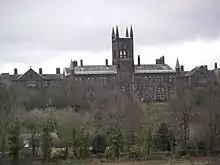Lancaster Moor Hospital
Lancaster Moor Hospital, formerly the Lancaster County Lunatic Asylum and Lancaster County Mental Hospital, was a mental hospital in Lancaster, Lancashire, England, which closed in 2000 (the mental health departments left in 1991, but others remained).
| Lancaster Moor Hospital | |
|---|---|
 The 1816 building in 2008 | |
 Location in Lancaster | |
| Geography | |
| Location | Lancaster, Lancashire, England |
| Coordinates | 54.049°N 2.772°W |
| Organisation | |
| Type | Specialist |
| Services | |
| Speciality | Psychiatry |
| History | |
| Former name(s) | Lancashire County Lunatic Asylum (1816-1930) Lancaster County Mental Hospital (1930-1948) |
| Opened | 1816 |
| Closed | 2000 |
Listed Building – Grade II* | |
| Official name | Moor Hospital, Blocks 40, 41, 42, 44 and 46 |
| Designated | 24 January 1994 |
| Reference no. | 1289436 |
Listed Building – Grade II | |
| Official name | Moor Hospital, New Block |
| Designated | 24 January 1994 |
| Reference no. | 1195079 |
Listed Building – Grade II | |
| Official name | Boundary walls, railings, gates and gate piers at Lancaster Moor Hospital |
| Designated | 13 September 2006 |
| Reference no. | 1391761 |
History

The main building, which was designed by Thomas Standen, was opened as the First Lancashire County Asylum in 1816.[1] It was extended at various times until 1850, and is grade II* listed.[2] A further building, which was designed by Arnold W. Kershaw in the gothic style and known as "the Annexe", was completed in 1883 and is grade II listed,[3] as are its walls, railings, and gateways.[4] The hospital's chapel, which was designed by Edward Graham Paley, was built in 1866 and is grade II listed.[5]
Campbell House, a facility for paying "gentlemen" patients, was completed in 1909.[6] And the Ladies' Villa, Also Known as Ridge Lea, a facility for paying "lady" patients, was completed in 1916. The Ladies Villa was big enough to be classed as its very own small Mental Asylum.[7]
The hospital was a pioneering site for the humane treatment of the mentally ill with the introduction of treatments such as electroconvulsive therapy (ECT).[8] The writer Alan Bennett describes his mother's treatment in the hospital in his memoirs.[8]
Following the introduction of Care in the Community in the early 1980s, the hospital went into a period of decline and closed in 2000; the Annexe and chapel have since been converted into apartments, and houses have been built in the grounds.[9][10]
The hospital was renamed as Lancashire County Mental Hospital in 1930, and as Lancaster Moor Hospital in 1948.[11]
See also
- Grade II* listed buildings in Lancashire
- Listed buildings in Lancaster, Lancashire
- Prestwich Hospital, the second Lancashire County Asylum
- Rainhill Hospital, the third Lancashire County Asylum
- Whittingham Hospital, the fourth Lancashire County Asylum
- Winwick Hospital, the fifth Lancashire County Asylum
- Calderstones Hospital, the sixth Lancashire County Asylum
References
- Lewis, Samuel (1848). "'Lambley - Lancaster', in A Topographical Dictionary of England". London: British History Online. pp. 6–17. Retrieved 4 October 2018.
- Historic England. "Moor Hospital, Blocks 40,41,42,44 and 46 (1289436)". National Heritage List for England. Retrieved 12 February 2023.
- Historic England. "Moor Hospital, New Block (1195079)". National Heritage List for England. Retrieved 2 July 2014.
- Historic England. "Boundary walls, railings, gates and gate piers at Lancaster Moor Hospital (1391761)". National Heritage List for England. Retrieved 2 July 2014.
- Historic England. "Church of St Michael, Moor Hospital (1289454)". National Heritage List for England. Retrieved 2 July 2014.
- "Lancaster Moor". County Asylums. Retrieved 15 October 2018.
- "Ridge Lea Asylum". Beyond the point. Retrieved 28 June 2023.
- Woodend, Joscelin (18 December 2013). "The Evolution of the Treatment of the Mentally Ill: How Lancaster County Lunatic Asylum Changed the Face of Treatment". New Histories. 5 (2). Archived from the original on 14 July 2014. Retrieved 2 July 2014.
- Riley, Sue (5 February 2013). "Lancaster's Moor Hospital to be transformed in multi-million pound housing property development". Lancashire Life. Retrieved 2 July 2014.
- Law, Cally (4 May 2014). "Asylum seekers". Sunday Times. Archived from the original on 14 July 2014. Retrieved 2 July 2014.
- Watts-Tobin, Mary Ann (1 October 2010). "A history of Lancaster Moor Hospital". Morecambe Bay Medical Journal. 6 (3): 71–74. doi:10.48037/mbmj.v6i3.307.
External links
- "Lancaster Moor Hospital, Lancaster". Hospital Records Database. The National Archives. Retrieved 2 July 2014. Index of locations of records of the hospital
.jpg.webp)